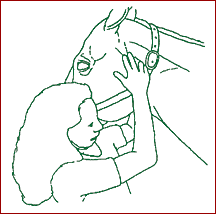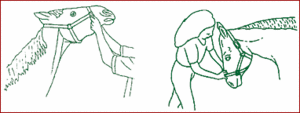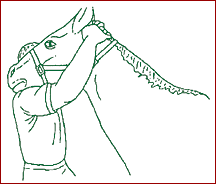I won't leave you hanging. The Nevada and Washington state veterinary boards sued me because they claimed by simply teaching animal chiropractic, I was practicing veterinary medicine without a license: never mind that I never conducted a practice in those states!
I'd like to impart some information that aspiring animal adjusters can use.
Can a Chiropractor Legally Adjust Animals and Get Paid for It?
The short answer is yes, but I advise any licensed chiropractor to contact his or her state and veterinary board and ask that question. Get the answer in writing. Most states will allow chiropractors to adjust animals if they obtain a veterinary referral from the animal's vet - not just any vet. Some states (New York and Kentucky) will not allow this, unless their laws have recently changed. A veterinary referral does not mean the chiropractor goes directly to the vet. The chiropractor is hired by the animal owner. It is then up to the owner to ask the vet for the referral - again, in writing.
This may seem a bit odd, but it's "more legal" for a laypersons to adjust animals, as long as they don't call it chiropractic. Laypersons are not perceived as liable under anyone's professional jurisdiction. Naturally, there are some exceptions to this. A layperson's operative euphemism is "skeletal balancing." This term is used mostly by equine massage therapists that have added manipulation to their lists of services, and don't want to get into trouble.
Technique - Adjusting the Horse's Atlas
Each article I write for Dynamic Chiropractic will detail a particular technique you can use on animals. Since horses and dogs seem to interest everyone, I'll focus on them. There are some animal chiropractors who claim to adjust more exotic animals (birds and dolphins - yes, dolphins). I get this image of adjusting a dolphin in a Gonstead cervical chair, or performing a "short fin" test!
While I don't adjust birds, I have learned two aspects of their anatomy: All flight birds have hollow bones, and their vertebrae past the last cervicals are fused. An audible produced at T4 is not the desired cavitation.
The two areas of the horse's body that need to be adjusted the most are the atlas and the pelvis. These two areas are particularly vulnerable to subluxations because there is so much movement there. When the horse unexpectedly jerks its head, a muscle spasm will arise, generally on one side of the atlas, causing impeded movement.
For those dealing with horse owners, you will often hear the word "poll" used. The poll is really the back of the occiput, more precisely, the EOP (external occipital protuberance). But in the vernacular, if a horse has something wrong with its poll, its atlas needs to be adjusted, and you're restoring motion to the atlanto-occipital joint. This joint is known as the "yes" joint because it allows for extension (head up), and flexion (head down).
By comparison, a dog has much more extension at the poll than a horse. A dog can extend the head up until the nose points toward the ceiling. A horse has one-third less extension. With a cat, no one knows. The reason why a horse has less extension at the poll is because the occipital condyles are long and protrude deeply in the atlas sulci. A dog's atlas sulci are shallow and allow for more movement.
Testing the Atlas for Subluxations
I think we can all agree that before adjusting the atlas, the first step is to find the misalignment and the area of pain. For this there are two tests: static palpation and motion palpation.
The static palpation test is to stand in front of the horse and place two fingers (length wise) into the space between the atlas wing (which is huge) and the mandible, on both sides (see Figure I). Make sure the horse is standing square and its head is straight. The narrower of the two sides is the painful side. The muscle here is often knotted and may spasm when probed, causing the horse to react.
| Figure 1: Feeling the spaces between the atlas wings (transverses) and the jaw to determine which side feels narrower. |
Having found the closed side, it's time to motion palpate the joint. Stand in front of the horse, grab the nose halter on each side and lift up the horse's head to maximum extension (Figure 2). Does it fight you? Next, laterally bend the head to one side, then lift up again. Repeat for the other side. Which side felt heavier going up? It should be the closed side, as demonstrated with the static palpation test. That's the side you need to adjust.
| Figure 2: Motioning the "yes" joint and testing for fixations. |
I know of four ways to safely and effectively adjust the poll: There are probably more, but the one that I find the most efficient is t the "posterior (dorsal) arch move." The main reason to use other atlas moves is if this one cannot be done due to the horse being too tall for the practitioner or too ornery.
For the posterior arch move, stand in front of the horse on the side opposite the misalignment and clasp your hands around the atlas (posterior arch) while the horse's chin is resting on your shoulder (your shoulder acts as a table). As in most adjustments, before the thrust or impulse, you stretch the joint and bring it to tension. For this you'll need to push down on the atlas and at the same time, lean backward to "gooseneck" the joint. Once this is done, pivot your shoulders away from the misalignment. This opens up the closed side. Now the joint is fully stretched. Lastly, while maintaining this sturdy position, quickly impulse straight down and release. You might get an audible. An audible isn't necessary to prove the success of the adjustment. Simply retest the motion test (the "yes" test) and see if both sides feel equal.
| Figure 3: The set-up for the dorsal arch move. |
In future articles, I will discuss protocol, techniques, fees, and practice building. Getting new animal patients is easy.
P.S. Remember, HMO does not stand for "horse maintenance organization."
Daniel Kamen,DC
Buffalo Grove, IL
http://www.animalchiropractic.com
(AVCA website: http://www.animalchiropractic.org)







